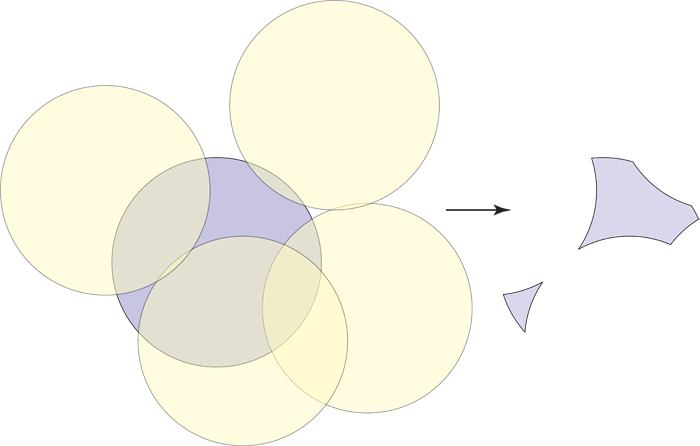Here is a "pretty vanilla" mathematical solution to your problem, which works in $n^3$ time, but programming it is quite easy, it's a matter of 1 hour.
In the beginning we throw away every $C_i$ ($1\leq i\leq n$) that doesn't intersect $C_{n+1}$.
We also throw away every $C_i$ ($1\leq i\leq n$) that lies inside another $C_j$ ($1\leq j\leq n$).
From now on we consider "lunar shades" $L_{i}=C_{n+1} \cap C_{i}$, where $1\leq j\leq n$. Some $L_i$ may remain equal to whole $C_i$, of course.
The initial problem is then equivalent to the following: is $C_{n+1}$ equal to the union $U=\cup_{i=1,\ldots, n} L_i$?
We will reformulate it in this way: is the boundary $\partial U$ equal to the boundary circle $\partial C_{n+1}$. To check this we do the
Check 0) We check the outer border $\partial C_{n+1}$). To do that we find all points $p_j$ which $\partial C_i$ ($1\leq j\leq n$) cut on $\partial C_{n+1}$. Then we sort all these points on theri angle coordinate on $\partial C_{n+1}$, obtaining sorted points $t_j$ ($j=1,\ldots,K\leqslant 2n$). And then for every $j=1,...,K$ we check the middle of the segment $[t_j,t_{j+1}]$ -- whether it belongs to some circle $C_i$ with $1\leq i\leq n$. Of course, we also check the middle point of $[t_K,t_1]$. If some middle points fails, then we are done, and this point is not covered.
If not, we continue and check if $\partial U$ doesn't contain points inside $C_{n+1}$. We do that with
Checks 1...n )
They exactly similar to the Check 0, but we consider the arc $A_j$ of $C_j$ which is inside $C_{n+1}$ as the segment of check. So we again find the points which $C_i$ sect on $C_j$ within $A_j$, including additionally the ends of $A_i$. Then we sort these points up to $C_j$'s angle coordinate and check the middle points -- whether each of them is covered by some circle. If one of these checks fails, we find uncovered points. If all such checks succeed -- then $C_{n+1}$ is covered.
P.S. Using the simple algorithm $n \log n$ for computing the union of segments on a border of circle, one can reduce the complexity to $n^2 \log n$.

